
Frederick Augustus I was a member of the House of Wettin who reigned as the last Elector of Saxony from 1763 to 1806 and as the first King of Saxony from 1806 to 1827. He was also Duke of Warsaw from 1807 to 1815, and a legitimate candidate to the Polish throne.
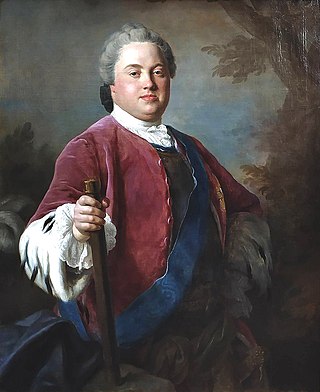
Frederick Christian was the Prince-Elector of Saxony for 73 days in 1763. He was a member of the House of Wettin. He was the third but eldest surviving son of Frederick Augustus II, Prince-Elector of Saxony and King of Poland, by his wife, Maria Josepha of Austria.

Augustus II, most commonly known as Augustus the Strong, was Elector of Saxony from 1694 as well as King of Poland and Grand Duke of Lithuania in the years 1697–1706 and from 1709 until his death in 1733. He belonged to the Albertine line of the House of Wettin.

Augustus III was King of Poland and Grand Duke of Lithuania from 1733 until 1763, as well as Elector of Saxony in the Holy Roman Empire where he was known as Frederick Augustus II.
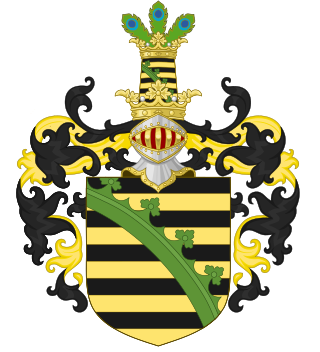
The House of Wettin was a dynasty of German kings, prince-electors, dukes, and counts that once ruled territories in the present-day German states of Saxony, Saxony-Anhalt and Thuringia. The dynasty is one of the oldest in Europe, and its origins can be traced back to the town of Wettin, Saxony-Anhalt. The Wettins gradually rose to power within the Holy Roman Empire. Members of the family became the rulers of several medieval states, starting with the Saxon Eastern March in 1030. Other states they gained were Meissen in 1089, Thuringia in 1263, and Saxony in 1423. These areas cover large parts of Central Germany as a cultural area of Germany.

Heinrich, count von Brühl, was a Polish-Saxon statesman at the court of Saxony and the Polish–Lithuanian Commonwealth and a member of the powerful German von Brühl family. The incumbency of this ambitious politician coincided with the decline of both states. Brühl was a skillful diplomat and cunning strategist, who managed to attain control over of Saxony and Poland, partly by controlling its king, Augustus III, who ultimately could only be accessed through Brühl himself.

The Kingdom of Saxony, lasting from 1806 to 1918, was an independent member of a number of historical confederacies in Napoleonic through post-Napoleonic Germany. The kingdom was formed from the Electorate of Saxony. From 1871, it was part of the German Empire. It became a free state in the era of Weimar Republic in 1918 after the end of World War I and the abdication of King Frederick Augustus III of Saxony. Its capital was the city of Dresden, and its modern successor state is the Free State of Saxony.

John George I was Elector of Saxony from 1611 to 1656. He led Saxony through the Thirty Years' War, which dominated his 45-year reign.

John George IV was Elector of Saxony from 1691 to 1694.

Maria Josepha of Austria was the Queen of Poland and Electress of Saxony by marriage to Augustus III. From 1711 to 1717, she was heir presumptive to the Habsburg Empire. Her sister Maria Amalia became Electress of Bavaria.

Brühl's Terrace is a historic architectural ensemble in Dresden, Germany. Nicknamed "The Balcony of Europe", the terrace stretches high above the bank of the river Elbe. Located north of the recently rebuilt Neumarkt Square and the Frauenkirche, is one of the favourite inner-city places of both locals and tourists for walking, people watching, and having a coffee.

Augustus was Elector of Saxony from 1553 to 1586.

The Electorate of Saxony, also known as Electoral Saxony, was a territory of the Holy Roman Empire from 1356–1806. It was centered around the cities of Dresden, Leipzig and Chemnitz.
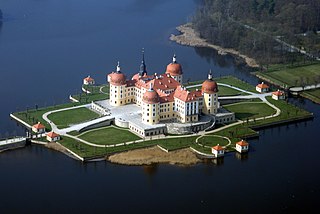
Moritzburg Castle or Moritzburg Palace is a Baroque palace in Moritzburg, in the German state of Saxony, about 13 kilometres (8.1 mi) northwest of the Saxon capital, Dresden. The castle has four round towers and lies on a symmetrical artificial island. It is named after Duke Moritz of Saxony, who had a hunting lodge built there between 1542 and 1546. The surrounding woodlands and lakes were a favourite hunting area of the electors and kings of Saxony.

Wermsdorf is a municipality in the Nordsachsen district in Saxony, Germany. Two hunting castles of the Saxon Dukes and Kings are to be found here.

Frederick Augustus, Count Rutowsky, was a Saxon field marshal who commanded Saxon forces in the Siege of Pirna during the Seven Years' War.
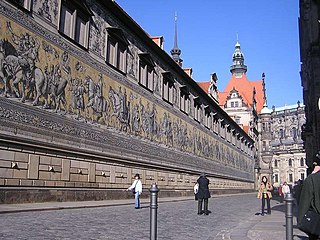
The Fürstenzug in Dresden, Germany, is a large mural of a mounted procession of the rulers of Saxony. It was originally painted between 1871 and 1876 to celebrate the 800th anniversary of the Wettin Dynasty, Saxony's ruling family. In order to make the work weatherproof, it was replaced with approximately 23,000 Meissen porcelain tiles between 1904 and 1907. With a length of 102 metres (335 ft), it is known as the largest porcelain artwork in the world. The mural displays the ancestral portraits of the 35 margraves, electors, dukes and kings of the House of Wettin between 1127 and 1904.

Anton Egon, a member of the Swabian House of Fürstenberg, was Imperial Prince and Princely Landgrave of Fürstenberg-Heiligenberg from 1674 until his death. He also served as governor of the Electorate of Saxony under the Wettin prince-elector Augustus II the Strong.
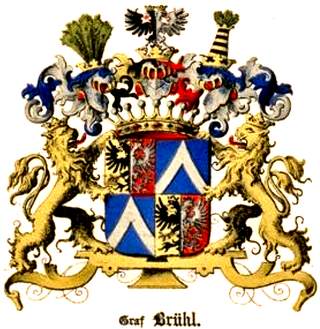
The Brühl family is an old German noble family from Saxony-Thuringia, with their ancestral seat in Gangloffsömmern in Thuringia. Branches of the family still exist today.

The history of Saxon coinage or Meissen-Saxon coinage comprises three major periods: the high medieval regional pfennig period, the late medieval pfennig period and the thaler period, which ended with the introduction of the mark in 1871/72. Rich silver deposits, which were discovered near Freiberg after the middle of the 12th century, helped Saxony to a leading position in German coinage.























